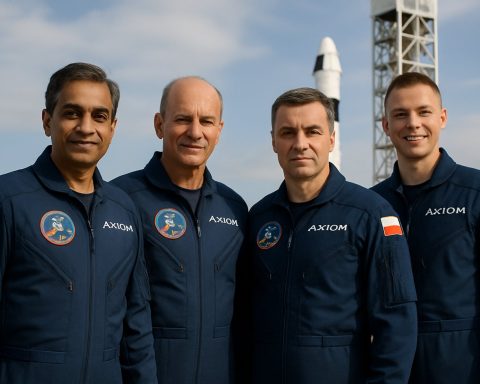- The new Sinai Astronomical Observatory is being constructed atop Mount Al-Rujum in South Sinai, offering an ideal location for celestial observation due to its elevation and reduced light pollution.
- Egypt’s original Kottamia Observatory faces challenges due to urban sprawl, prompting the need for the new facility.
- The Sinai Observatory will house a 6.5-meter mirror telescope, the largest in the Middle East, aiming to enhance observational capabilities and unlock cosmic mysteries.
- Site preparation involves a comprehensive two-year atmospheric study to ensure optimal conditions for observation.
- Egypt plans to establish an astronomical city as a global hub for optical and radio astronomy, reinforcing its position in the scientific community.
- The new observatory signals not just a replacement but a transformative leap into advanced astronomical research for Egypt.
Hovering majestically above the sweeping landscapes of Egypt, the summit of Mount Al-Rujum in South Sinai is on the brink of transforming into a beacon for celestial exploration. Here, amid the tranquility of the towering peaks, the construction of Egypt’s groundbreaking new observatory is quietly taking shape, bidding to eclipse its storied predecessor, the Kottamia Astronomical Observatory.
The Kottamia Observatory, nestled 80 kilometers from Cairo, has long stood as a testament to Egypt’s astronomical ambitions. Established in 1964, its crowning jewel, a 188 cm diameter telescope, was the pride of the Arab world. Yet, the relentless sprawl of urban life threatened its efficacy, whispering a need for change carried by the winds of time.
With unwavering resolve, Egypt embarks on a celestial odyssey atop Mount Al-Rujum, one of the twenty highest peaks in Egypt. The mountain’s elevation provides an impeccable vantage point for astronomical observation, far removed from the embrace of light pollution that so often dims the heavens. It is here that the new “Sinai” Astronomical Observatory takes root, under the auspices of the National Research Institute of Astronomy and Geophysics (NRIAG).
Meticulous preparation is underway, spearheaded by a dedicated team of experts led by Dr. Hadia Selim and comprising notable figures like Dr. Yousry Azzam and Dr. Mohamed Ismail, along with their skilled technicians. Their mission is clear: to ensure that the new astronomical center is equipped to pierce the cosmos with an audacious 6.5-meter mirror telescope—the largest in the Middle East.
This technological marvel promises not just a leap but a bound into new realms of discovery. The telescope is poised to unlock the secrets of the universe, shattering the glass ceiling of current observational capabilities.
Site testing, an intricate tapestry woven over two years, begins with the careful installation of specialized equipment. This initial network of instruments measures myriad atmospheric conditions and preliminary observation parameters. Each data point, collected from remote devices and relayed via satellites, is cross-verified at NRIAG’s facilities in Helwan to guarantee that Mount Al-Rujum’s lofty heights offer a celestial canvas unmarred by terrestrial interference.
Egypt’s bold vision goes even further, encompassing an entire “astronomical city” dedicated to both optical and radio astronomy. This integrated hub will position Egypt not just as a regional leader but as a formidable global presence in the field of astronomy, adaptive to swift technological progress.
As the Sinai Astronomical Observatory unfolds, Egypt sketches a new chapter of scientific inquiry and discovery. The new facility is not merely a replacement but a rebirth, propelling Egypt into a future where the stars are not just seen, but understood.
The takeaway: Beneath the vastness of inky skies, Egypt is crafting a new era of astronomical exploration—a pursuit that melds tradition with innovation, steadfastly focused on unraveling the mysteries above.
Why Egypt’s New Observatory Will Revolutionize Astronomical Research
Egypt’s Astronomical Ambitions: A Historic Perspective
Egypt has long harbored dreams of space exploration, with the Kottamia Astronomical Observatory once standing as the beacon of those aspirations. Built in 1964, it housed a 188 cm telescope, which was a remarkable achievement for its time. However, urbanization around Cairo has since introduced light pollution, limiting its effectiveness and signaling the need for a new, more advanced facility.
The Sinai Astronomical Observatory: Setting New Standards
Key Features and Innovations
– Location and Design: Positioned on Mount Al-Rujum, one of the top 20 highest peaks in Egypt, the observatory’s location capitalizes on minimal light pollution and high altitude to ensure optimal viewing conditions.
– Advanced Telescope: At the core of the observatory is a revolutionary 6.5-meter mirror telescope, set to be the largest in the Middle East. This will dramatically enhance Egypt’s ability to observe distant celestial phenomena and contribute to astronomy on a global scale.
– Integrated ‘Astronomical City’: Beyond optical observations, the observatory will support radio astronomy, turning the site into a comprehensive research hub.
How-To: Building a World-Class Observatory
1. Site Selection: Choose a high-altitude location to minimize interference from earthly light sources.
2. Equipment Installation: Begin with atmospheric testing to establish a baseline for data integrity.
3. Collaborative Expertise: Assemble a team of specialized scientists and technicians to lead construction and operational phases.
4. Technology Integration: Use cutting-edge satellite communications to facilitate data transfer and analysis.
Market Forecasts and Industry Trends
With global investments in astronomy and associated technologies on the rise, Egypt’s new observatory positions it favorably within the larger scientific community. The facility’s construction aligns with trends toward multinational collaborations in space exploration and research.
Controversies and Limitations
While the new observatory presents unprecedented opportunities, challenges remain. Financing such a project is substantial, and operational costs are ongoing. Additionally, maintaining state-of-the-art technology requires continuous updates and skilled personnel.
Real-World Applications and Use Cases
1. Educational Outreach: The observatory can serve as a center for astronomical education, offering hands-on learning for students across disciplines.
2. Scientific Partnerships: Potential collaborations with international research institutions will enrich the collective understanding of our universe.
Security and Sustainability
Eco-friendly construction practices in the observatory’s development can lower environmental impacts, aligning with global sustainability goals.
Concluding Actionable Tips
– Engage with Astronomy: Attend public nights at local observatories or join online astronomy forums to deepen your understanding of celestial phenomena.
– Support Scientific Initiatives: Advocate for local and national scientific investments that contribute to global knowledge sharing.
Related Reading
For further exploration of scientific and technological advances, visit the National Research Institute of Astronomy and Geophysics (NRIAG).
By building a world-class observatory, Egypt invites not only its own citizens but the entire world to look up with renewed curiosity and excitement about the stars that have always been our guides.







